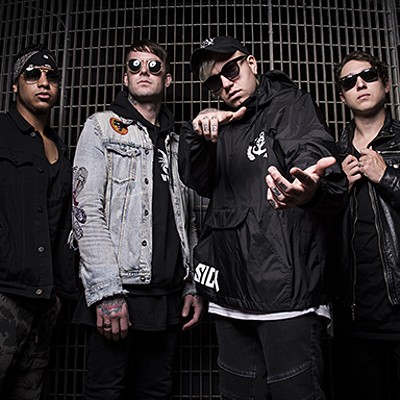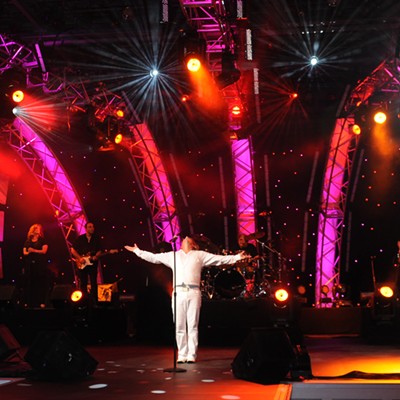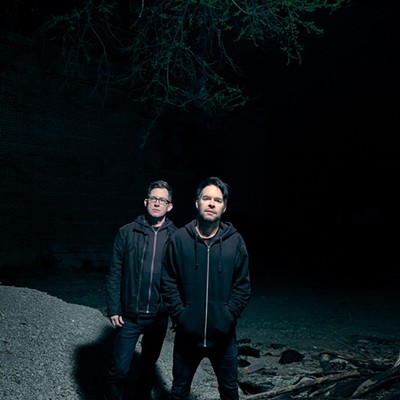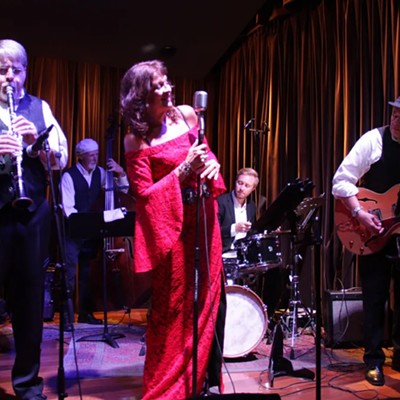It's a heady combination which has evolved from the band's 2001 debut Biggest Bluest Hi-Fi, through the sophomore album Underachievers, Please Try Harder in 2004, to its month-old third CD, Let's Get Out of This Country.
The Glaswegian sextet's musical approach, at once nostalgic and contemporary, has garnered widespread popularity in the United Kingdom and cult attention from American fans.
Nigel Baillie, the band's trumpeter, said Camera Obscura's music is intended to evoke a sense of timelessness.
"It was obviously an active decision by the members of the band in its early stages to write in that style, and I think it has proven to be a fairly consistent direction for the last couple of years," Baillie said.
"I think a lot of us in the band feel a kinship with that sort of 1950s/early '60s American pop that we all have listened to for most of our lives--Motown Records, Nancy Sinatra, Petula Clark, that sort of thing. I wouldn't say that's necessarily only the case. We all listen to music from various eras. Tracyanne, as well, is very influenced by '80s pop music, and she is very into many current bands."
Baillie spoke with the Weekly last weekend, via cell phone while the band was en route from Philadelphia to Washington, D.C., for a gig.
Camera Obscura recently embarked on its second North American tour, which will last more than a month and come to Tucson on Monday, July 17, for a performance at Plush.
On the group's last tour of the United States a couple of years ago, they never went further west than Atlanta, so Baillie said he is especially excited to visit the Southwest and the West Coast.
Although Camera Obscura has been playing gigs and recording since the turn of the century, Baillie says it was formed as a concept in Campbell's mind when she met former band guitarist John Henderson in college around 1996.
"That was the initial germ of the band," Baillie said. "She kind of wanted to be in the band before there were any songs, and she reckoned she'd form the band before she played the guitar."
Recording started on Biggest Bluest Hi-Fi in 2000, and that's when Baillie, a veteran of Scottish orchestras and brass bands, was hired to play as a session musician, he said.
"When the band started doing shows to promote the album, I ended up doing all the shows, and all the shows since then. I was then asked if I wanted to be a member, and have been with the band since."
On stage, Baillie also plays a fair amount of percussion and a little guitar to spell Campbell.
The baroque chamber-pop nature of Camera Obscura's recordings--full of string sections and elaborate instrumentation--makes it hard to replicate the songs note for note on stage. Baillie views performances and recordings as separate beasts.
"It's impossible to re-create exactly what a song sounds like when we play on stage. But we try our best to keep it as close to the record as possible. I think we've been surprised, so far, at our success in achieving that. But, ultimately, I very much feel they are two distinct things."
Among the enticements of Camera Obscura's songs is the juxtaposition of breezy, catchy tunes with the wrenching emotional feelings inherent in Campbell's lyrics, especially on tunes from the new album such as "Lloyd, I'm Ready to be Heartbroken," "Tears for Affairs" and "I Need All the Friends I Can Get."
When asked about this tendency, Baillie demurred, but only for a moment. "It's probably wrong for me to try and answer that for Tracyanne. But certainly, this is a question that has been asked about this album a lot recently." He allows that most of Campbell's tunes have an autobiographical foundation over which she embellishes with literary license.
"It's safe to say that this album largely has to do with her own life over the last couple of years, especially the breakup of a relationship," he said.
"Tracyanne has often said she just writes what she feels. She thinks about these feelings deeply, and whatever she is focusing on at the time comes out in her music."
Let's Get Out of This Country differs from the first two Camera Obscura albums in that the band members chose to use the services of an outside producer rather than produce it themselves.
They traveled last fall to Stockholm, Sweden, to work with Jari Haapalainen, who had impressed Camera Obscura with his production of albums by artists such as The Concretes, Ed Harcourt and International (Noise) Conspiracy. Critics have praised the results as richer and bolder than the band's past albums.
Baillie doesn't think Haapalainen changed Camera Obscura's sound much, but helped refine their vision and add nuance in the studio. "We kind of let go of control a little bit, and that felt good in a creative way."
Camera Obscura did, however, work with an outside producer once before, albeit briefly. Stuart Murdoch, singer-songwriter for fellow Glasgow band and indie-rock superstars Belle and Sebastian, was behind the mixing board for the early single "Eighties Fan."
But Baillie believes Murdoch's influence on Camera Obscura, and any similarities between the two groups, have been overemphasized in the music press.
"We know the guys from Belle and Sebastian. They're friends; we all like them and their music. Stuart was quite helpful and encouraging when we were getting things up and running, but there's never been any connection since then.
"We do get a bit fed up with the comparisons all the time, and we understand why people make them. But when all is said and done, there are far worse bands we can be compared to."










